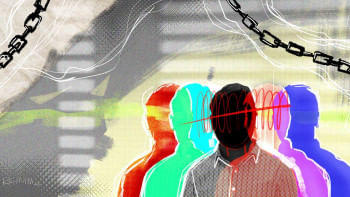Locate and free all victims of enforced disappearance

For over a decade, hundreds of families in Bangladesh have lived with the unbearable pain of not knowing the fate of their loved ones. These individuals—mostly critics and political rivals of Awami League—disappeared during its 15-year rule, allegedly abducted by state agencies. The government's fall has now reignited the hopes of their families, but it is a tragic reflection of our times that there is still no end date on their never-ending misery. According to a report, over 100 such families formed a human chain on Saturday, demanding information about the whereabouts of their loved ones. They held up photos of their missing sons, husbands, and fathers, some of whom disappeared as far back as 13 years ago.
These families deserve answers, justice, and closure. Unfortunately, they are yet to have the chance to move in that direction. Although the Directorate General of Forces Intelligence (DGFI) authorities already said that there are no detainees in their Dhaka facility, popularly known as "Aynaghor", the release of some former prisoners has raised hope that many of the disappeared could still be alive in other secret internment centres of the security forces. The DGFI reportedly promised to form a joint commission to inspect 23 other facilities across the country to see if the victims of enforced disappearance were there. The question is, how many detention-cum-torture cells are there, really? How many of the hostages held illegally over the years are still alive? How many perished in obscurity?
In a report in 2021, the Human Rights Watch said there was no trace of nearly 100 out of the 600 people who had disappeared during Hasina's rule. The number of the disappeared could be more than 700, according to Odhikar, which says some 150 are believed to remain missing. Clearly, because of the cloak of secrecy in which those behind the illegal operations wrapped themselves, there remains a huge information gap which could complicate any future effort to shine a light on all such cases and indeed to pursue justice for the security officers and services responsible.
Besides enforced disappearance, the Awami League regime had also been regularly accused of allowing extrajudicial killings and custodial torture, and so the interim government must start the process of establishing justice for all such activities. The immediate priority, of course, will be to locate and release all enforced disappearance victims. For too long, these people and their families have endured unimaginable suffering, which must come to an end. The authorities should also set up an independent justice mechanism with the UN's support to investigate each of the incidents, and put the perpetrators on trial. After Sheikh Hasina's ouster, the nation finally has a chance to unearth the full horrors of enforced disappearance and rectify the state machinery involved.


 For all latest news, follow The Daily Star's Google News channel.
For all latest news, follow The Daily Star's Google News channel. 










Comments